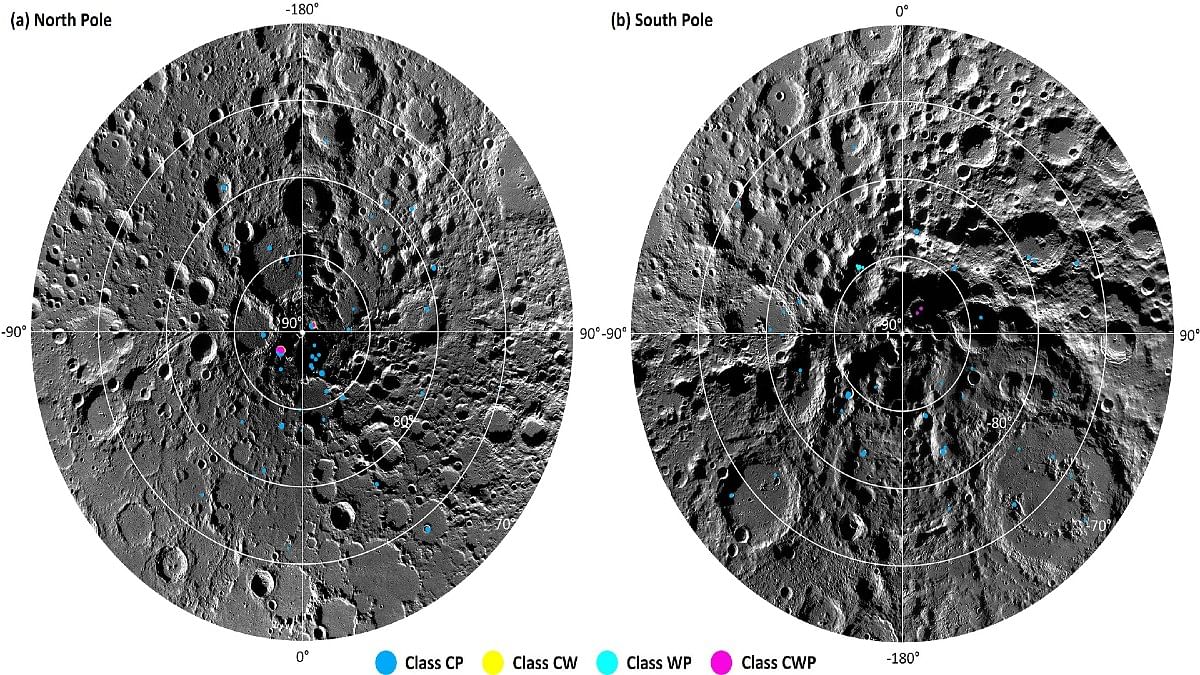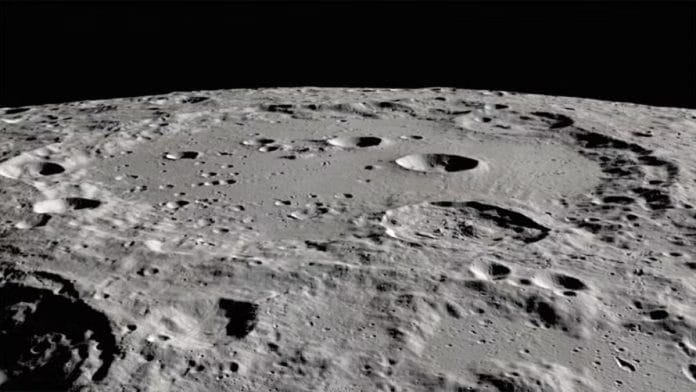Bengaluru: The reserves of underground ice at both poles of the Moon in the first few metres of depth are five to eight times larger than ice on the surface at both poles. This is one of the key findings of a study conducted by a team of scientists from ISRO’s Space Applications Centre (SAC), in collaboration with NASA’s Jet Propulsion Laboratory (JPL), IIT Kanpur, IIT Dhanbad, and the University of Southern California.
The team worked with instruments and data collected from NASA’s Lunar Reconnaissance Orbiter (LRO), to study the distribution of ice on the Moon. The findings, which have been peer-reviewed, were published this week in the Journal of Photogrammetry and Remote Sensing.
The latest study from India’s space agency offers more hope. Taken together with another ISRO study published a few months ago in the peer-reviewed Journal of Geophysical Research, showing Chandrayaan 2’s evidence of subsurface polar ice, the findings firmly indicate that the amount of underground ice at the Moon’s poles for a depth of up to three meters is 5 to 8 times more than that at the surface.
The two studies together point out to the ice content at both poles as not only being much more than previously believed, but also being viable enough to be drilled and used as a water resource.
“The presented comprehensive understanding of the occurrence of water ice in the lunar poles, in this study, is crucial for supporting ISRO’s future in-situ volatile exploration plans on the Moon,” ISRO said in a statement.
Since its discovery in 2010, water ice on the Moon has been an attractive proposition for many space missions in recent times as well as those planned over the upcoming decades. Over the last decade, scientists clamoured to understand the extent, spread, and quantity of lunar water ice, to gather as much information as possible for upcoming lunar missions and future human settlements.
The Moon, being the closest astronomical body to Earth, is expected to function as a base for astronomy and exploration of the solar system in the future. Thus the presence of water, liquid or frozen, implies that humans can obtain a valuable resource in situ or on location.
Water ice was discovered originally on the Moon’s South Pole (confirming scientific predictions) by the Chandrayaan 1 mission’s NASA and ISRO instruments independently. The orbiter carried an impactor that was flung onto the Moon’s surface at the South Pole, displacing the top layers of soil and revealing ice underneath. The impact occurred on India’s first Prime Minister’s birth anniversary, and the point was named ‘Jawahar Sthal’ on the suggestion of former President A.P.J. Abdul Kalam to honour Nehru’s creation of INCOSPAR, which later became ISRO.
Studies over the last decade, and missions, like the Chandrayaan series, have focused on the Moon’s South Pole, and have discovered large quantities of ice on the surface. The presence of water in situ is a big advantage as it is freely available for use, lowering costs of launch from Earth.
Many future missions are slated to land here to study the ice, including missions from India (Chandrayaan 4), China (Chang’e), Russia (Luna), USA (Artemis), etc.
Water can also be used to provide fuel by breaking down its molecules and extracting hydrogen, or extracting oxygen for breathing.
The drastic drop in costs caused by the availability of water ice has accelerated public and private missions to the Moon for commercial, educational, and scientific purposes, as well as to begin establishing a permanent human presence on the surface.
The latest study further found data which suggests that the less explored North Pole holds twice as much ice as the South Pole does.
Also Read: Alternative landing site for Chandrayaan-3 on Moon has potential for future lunar experiments
Other findings
The new study also presents possible mechanisms for how the formation of ice came about on the Moon. By studying permanently shadowed regions (PSRs) using various remote sensing instruments on NASA’s LRO, the team was able to firstly confirm the presence of water ice in these craters that are untouched by sunlight at all times.
These craters tend to occur at the 80° to 85° latitude band at both poles. The scientists also discovered that on the North Pole, the majority of ice was on the near side of the Moon that faces the Earth, while at the South Pole, most of the polar ice was on the far side. This is an “antipodal” water ice distribution, and the team discovered that it corresponds to how volcanism is distributed near the holes.
This led the scientists to conclude that outgassing from volcanoes, back when the Moon used to be tectonically active millions of years ago, could be a likely source of water ice at the poles.

Additionally, water ice also displayed in longitudinal symmetry, from 90°W to 90°E, and this could indicate a pattern of cratering on the moon. This boosts the previous observations that have concluded that small impacts occurred on the Moon in the past the most frequently at the 90°W region, and small craters decline in frequency towards 90°E.
A continuous ballistic attack of such small rocks on the Moon could have activated the outermost layer of the surface or the crust, mixing material together, in a process known as impact gardening, redistributing water ice that had been created by volcanic outgassing. This could have led to the movement of water ice in the region in the top layers of the lunar regolith or soil.
On the other hand, larger craters followed the opposite trend, becoming more and more frequent moving from 90°W to 90°E. These craters push the regolith in when they hit the surface and also build up ejecta of regolith around in a process called regolith emplacement. This prevents the subsurface ice from being visible and also forming in the past, thus explaining the decrease of water extent moving from 90°W to 90°E.
The authors state in their paper that the findings presented will be crucial for future water sampling at lunar poles that will be conducted by humans or robotic missions. This process will be performed as a necessary step before humans attempt to set up base there.
“Accurate knowledge of the distribution and depth of water ice occurrence in the lunar poles, as presented in the investigations, is crucial for constraining the uncertainties in selecting future landing and sampling sites for missions aimed at exploring and characterising lunar volatiles,” the ISRO said in its statement.
(Edited by Gitanjali Das)
Also Read: India’s first space station and human mission to Moon: what ISRO is planning after Gaganyaan






